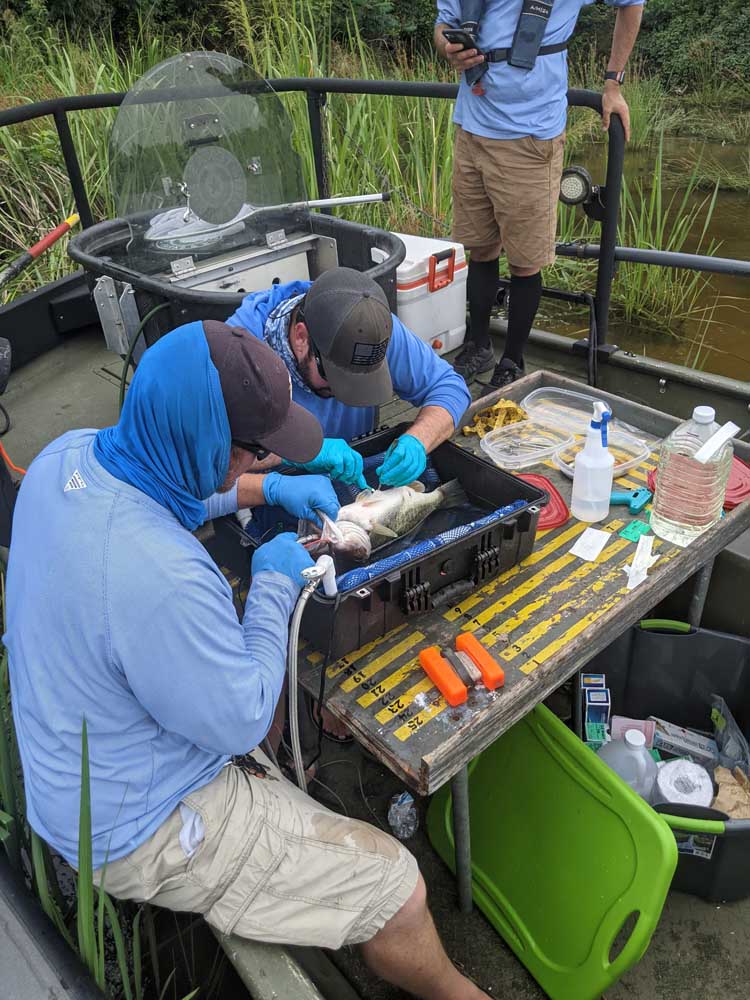Follow Up: TPWD Biologists Begin Round 2 Of Bass Tracking Study
Published 11:15 am Sunday, July 11, 2021

- Texas Parks and Wildlife biologists perform surgery on a fish to insert a transmitter for the department’s bass tracking study.
One of the conclusive things about the first year of Texas Parks and Wildlife Department’s bass tracking study on Lake Fork and Toledo Bend Reservoir is that it ran the gamut of weather.
From 100-plus degree days last summer to minus-3 or so last winter and everything in between, biologists got a chance to study the fish under all conditions.
The result on both lakes is that bass are primarily homebodies. Not just within the confines of Birch Creek on Fork and Housen Bay on Toledo Bend where the studies were conducted, but yards of where they were caught, fitted with transmitters and released. Even more so is that extreme weather either way did not cause the fish to move much at all.
“We had a few outliers, the same as they did on Toledo Bend, that would pick up and move all over the place, but most stayed within 100 yards for over a year. A lot of them were on the bank,” said Jake Norman, TPWD district biologist and one of the leads in the study.
Even in a potential once-in-a-lifetime weather year like 2020, the fish held tight to their home range.
“In the hottest part of last year and the craziest cold, the fish didn’t change their location. They were always within 30- to 40-yard area. And the depths, they stayed in 2 to 4 feet of water. I think we did have two fish in the cold freeze that moved out further in Birch than ever found, but one of those moved a lot already,” Norman said.
Most of the fish used in the Fork study initially came from shallow water. At Toledo Bend they had more of a mix, with fish initially caught shallow returning to shallow and those caught deep going back to deeper water. But even there, the two variants seemed to remain within a tight home range, with a few exceptions. The main difference came with deep water fish where some generally laid in ambush of prey fish, while others seemed to chase theirs down more.
Fishermen only reported catching two of the tagged fish during the past year on Fork, but judging by the hook holes in its jaw at least one had been caught numerous times.
The biologists conducting the studies lost contact with their fish several weeks ago as the transmitter batteries died, putting an end to the first year of the study, but new fish have been fitted with the transmitters and released. One difference from a year ago on Fork is that some of the fish came from deeper water. Last year they were all caught along the shore.
“Of the 14 we have tagged, six come from offshore. We will see if they make a lot of the movements people think they do. It is going to be fun following those fish because they are on one of the most community spots on the lake that is beat to death,” Norman said.
He added he expects to find those fish more scattered than what was discovered last year because of the pressure on the hole. He said there is seldom less than two boats on the spot at any time. The question is if the pressure moves the fish, how far do they go and do they come back.
Of course it is dependent on the fish surviving the invasive surgery required to insert the transmitter. Norman explained there is already added stress on bass caught in deep water, and that the surgery adds to it. So far all but one has survived.
Another difference is that the department was able to catch and tag larger fish, 18 inches and up, to see if that gives a different perspective.
About 20 fish have been fitted with transmitters and are currently being tracked on Toledo Bend.
There was one negative to the study last year. Several of the bass that were fitted with transmitters had their long antenna wires clipped either by unknowing fishermen who thought they were helping the bass despite having TPWD identification tags on them, or because of maliciousness by fishermen opposed to research. The antenna connected to the transmitter is a long wire, and if cut it reduces the ability to track the fish.
TPWD staff will be back on the lakes about every two weeks during the life of the transmitters to track the fish and to study the impact of boating activity near the fish and what the fish do after being caught.






